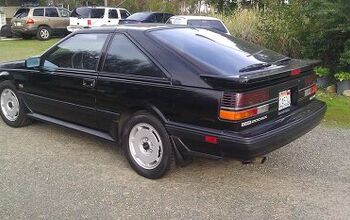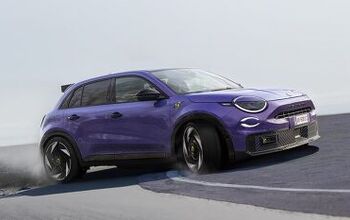ICYMI: The Nissan Quest Still Exists - Company Confirms 2017 Model
You can still buy a brand new Nissan Quest.
In fact, you’ll be able to do so in 2017, as well.
To be honest, we had our doubts about the Quest’s U.S. future. Nissan Canada killed the Quest in 2013. Fast forward three years, and Nissan USA’s lingering Quest suffered a massive 73-percent year-over-year sales decline between August and November of this year. During that period, only 0.5 percent of American minivan buyers, just one out of every 200, opted for a Nissan Quest.
With sales poor and inventory falling below 300 units nationwide, we became suspicious. Long after Nissan began featuring 2017 examples of the company’s current fleet on both its media and consumer websites, the Quest still only existed as a 2016 example. Time and again we made inquiries with Nissan. Time and again, Nissan responded with an absence of hard information.
This morning, however, was different. Our latest query, “Can we assume it’s dead, or is this just an extended hiatus before a 2017 Quest arrives?”, was met with a no.
“There will be a 2017 Quest,” Dan Passe, senior manager for Nissan product communications, told TTAC today. There’s no word yet on the exact timing of the on-sale date or any trim changes, or if the Quest will still fail miserably in the IIHS’s small overlap test.
But even with mere crumbs provided by Nissan so far, this is like the thrilling culmination to a 60 Minutes investigative report. PBS Frontline would have killed for this story. Ken Burns will someday film an historical montage revealing the inner secrets of TTAC’s quest to discover — or not discover, perish the thought — the long-awaited 2017 Quest.
We began pursuing the possible end-of-Quest-production story at the end of October. It is now the beginning of December. That’s the kind of sticktuitiveness, the dogged determination and fervent focus, that brings you back to TTAC day after day.
Okay, so it’s not The Next GT-R. For goodness’ sake, it’s not even a re-engineered Altima.
It’s a Nissan Quest: the most forgotten, ignored, and rejected minivan in America.
But with every indicator pointing the other direction, you heard it here — first, we think — that Nissan USA will import the fourth-generation Quest for a seventh model year.
The 2017 Nissan Quest lives.
Alas, it appears as though there will be no Mercury Villager twin.
Timothy Cain is the founder of GoodCarBadCar.net, which obsesses over the free and frequent publication of U.S. and Canadian auto sales figures. Follow on Twitter @goodcarbadcar and on Facebook.
More by Timothy Cain
Latest Car Reviews
Read moreLatest Product Reviews
Read moreRecent Comments
- Aaron This is literally my junkyard for my 2001 Chevy Tracker, 1998 Volvo S70, and 2002 Toyota Camry. Glad you could visit!
- Lou_BC Let me see. Humans are fallible. They can be very greedy. Politicians sell to the highest bidder. What could go wrong?
- SPPPP Vibrant color 9 times out of 10 for me. There may be a few shapes that look just right in metallic gray, for example. There are a few nices ones out there. And I like VW "White Silver". But I'd usually prefer a deep red or a vibrant metallic green. Or a bright blue.
- 28-Cars-Later Say it ain't so, so reboot #6* isn't going to change anything?[list=1][*]V4-6-8 and High "Tech" 4100.[/*][*]Front wheel drive sooooo modern.[/*][*]NOrthSTARt.[/*][*]Catera wooooo.[/*][*]ATS all the things.[/*][*]We're *are* your daddy's Tesla. [/*][/list=1]
- MaintenanceCosts Can I have the hybrid powertrains and packaging of the RAV4 Hybrid or Prime with the interior materials, design, and build quality of the Mazda?


































Comments
Join the conversation
I have a 2013 Quest LE (same model as this 2017). We purchased it before the crash tests came out. It is an exceptional family vehicle that we really like, and is very comfortable. We are a fan of the unique JDM qualities (better quality interior, super soft ride, cameras everywhere, power everything, unique styling). It's pushing 70k miles at this point. We average 21mpg regularly in mostly suburban driving. The Nissan dealer does charge a lot for maintenance. We've had to do new brakes ($500), tires ($900), CVT fluid change ($300) and a new battery ($220) outside of standard oil changes/rotations. The large LCD navigation screen sometimes goes haywire (but resets on every start up), otherwise the vehicle has been fine. Overall we do like it, however in general if anyone else asked my opinion on minivans (and they do), I typically tell them buy a Toyota Sienna. Unless you know/care what JDM means and owning something a bit unique, a Sienna will do everything equally good or better and probably have better long term quality and resale value. If Nissan consistently priced this $5k below a Sienna, it might be worth it and sales would rise, especially once the Caravan goes and there's no large value option left. With a strong dollar and long paid off tooling, they could probably afford to do so.
I have been driving a 1991 Toyota Previa for many years. Up until about 2 weeks ago it was NOT my daily driver, but my husband's daily driver's AC quit, so I gave him my Kia Forte and I'm back in the Previa. I love the Previa and it's always been our favorite road trip car. I will say, however, at 335,000 miles it's starting to feel a little long in the tooth. I'm STILL trying to decide what to replace it with. I must have a minivan, they are just too practical for words, so I'm deciding between a good late model Chevrolet Astro (a 2002 or more with less than 70,000 miles I can pick up for around $9k). OR, a 2013 or 2014 Nissan Quest. I want something UNIQUE, with captains chairs in the second row, just like my previa.